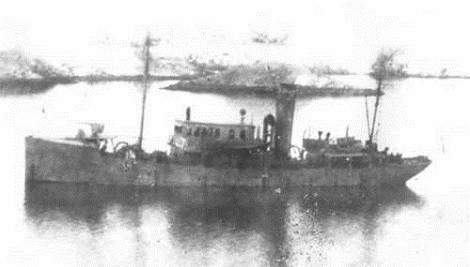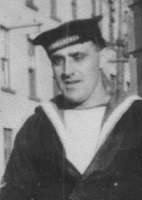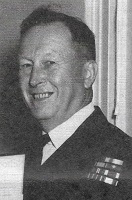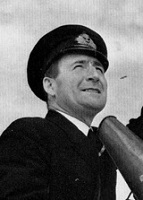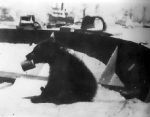|
HMCS THIEPVAL
Battle Class Trawler
Built at Kingston Shipbuilding Co., Kingston, Ont, she was launched in 1917 at Kingston, THIEPVAL was in commission between 24 Jul 1918 and 19 Mar 1920, when she was turned over to the Department of Marine and Fisheries as a patrol vessel. Taken back into the RCN, she was commissioned 02 Apr 1923, for service on the west coast. In Feb 1924, one of the few ships in the post-First World War Royal Canadian Navy, THIEPVAL became the first Canadian warship to visit the Soviet Union and Japan when it provided support for a British attempt to fly around the world. She was detailed to proceed across the north Pacific to Hakodate, Japan, to deposit fuel and lube "dumps" for the round-the-world flight of Maj. Stuart MacLaren. Travelling over 11,000 miles in the process, THIEPVAL also salvaged what remained of the aircraft after it was wrecked at Nikolski, USSR, on 03 Aug 1924. THIEPVAL was wrecked on an uncharted rock in Barkley Sound, B.C., on 27 Feb 1930.
Photos and Documents Ship's company photos
HMCS THIEPVAL - The accidental tourist destination
Commanding Officers
Lt, William James Robert Beech, RCN - 11 Feb 1924 - unk
LCdr Harold Reed Tingley, RCN - ?? - 27 Feb 1930
They shall not be forgotten
Photos and Documents
(TPV001) Article on HMCS THIEPVAL, HMCS GIVENCHY, HMCS ARMENTIERES and HMCS STADACONA transiting from Halifax to Esquimalt. THIEPVAL arrived safely in Esquimalt, while ARMENTIERES and GIVENCHY had to escort / tow STADACONA to San Francisco after she lost her rudder in a storm // The Daily Colonist, Victoria, BC, Saturday 24 May 1919 // Courtesy of Dwight Farrell (TPV002) HMCS THIEPVAL in Petropavlovsk harbour, 1924 (TPV003) Bruno was adopted in northern Japan by the crew of HMCS THIEPVAL and brought to Naden in 1924 // Source: CFB Esquimalt Naval and Military Museum
(TPV004) HMCS THIEPVAL in Nazan Bay, Atka Island, in the Aleutians // Nazan Bay was one of HMCS THIEPVAL'S last stops before the diminutive trawler crossed the north Pacific on the way to the Soviet Union and Japan. This hand-coloured photograph gives an idea of the barren shores THIEPVAL would visit during this 1924 journey. A secret component of the mission involved examining Alaskan and northern Japanese ports to determine whether the United States or Japan was contravening the 1922 Washington Naval Treaty by fortifying these areas. Reports by THIEPVAL'S commander, W.R.J. Beech, detailed resources, the presence of military or government officials, and the state of communications in several northern ports. // Source: George Metcalf Archival Collection // CWM 19710050-001_16 // Courtesy of the Canadian War Museum (TPV005) HMCS THIEPVAL'S 12-Pounder Cannon // Members of THIEPVAL'S crew maintain the ship's main armament, a 12-pounder cannon mounted on a platform in the bow. THIEPVAL'S limited weaponry was sufficient for the ship's peacetime patrol work. After being transferred to the west coast from Halifax in 1919, THIEPVAL'S duties included counting seals, patrolling against rum-runners, and ensuring that American fishing boats did not enter Canadian territorial waters. Years after THIEPVAL'S 1930 sinking, divers raised this gun and placed it on display at nearby Ucluelet, British Columbia. // Source: George Metcalf Archival Collection // CWM 19710050-001_86 // Courtesy of the Canadian War Museum (TPV006) Bruno with an unknown officer on HMCS THIEPVAL // In 1924, one of the few ships in the post-First World War Royal Canadian Navy, the Battle-class trawler HMCS THIEPVAL, became the first Canadian warship to visit the Soviet Union and Japan when it provided support for a British attempt to fly around the world. While in Hakodate, Japan, HMCS THIEPVAL'S crew adopted the small brown bear seen here and named him Bruno. Also known as "Haca-Daddy" (a play on "Hakodate"), Bruno shows up in a number of other photographs taken during THIEPVAL'S trip. Brought back to Canada, Bruno spent years living at HMCS NADEN, the Royal Canadian Navy's base at Esquimalt. Bruno subsequently developed a dependency on alcohol. Sadly, he came to a tragic end when he died of poisoning after ingesting dockyard supplies. // George Metcalf Archival Collection // Courtesy of the Canadian War Museum (TPV007) Soviet Soldiers and HMCS THIEPVAL Lieutenant // A group of Red Army soldiers and other onlooker's clusters beside one of HMCS THIEPVAL'S lieutenants // George Metcalf Archival Collection // Courtesy of the Canadian War Museum (TVP008) The RAF flying boat seen here involved in an ambitious round-the-world flight attempt // The British round-the-world flight attempt ended on this beach near Nikolskoye on Bering Island, off the Kamchatka Peninsula. // Soon after leaving Petropavlovsk, the Vickers Vulture flying boat made a forced landing in the ocean. The crew were able to get their aircraft to the nearest beach, but the damage seen here could not be repaired. HMCS THIEPVAL raced through the night to meet the stranded crew and then salvaged their aircraft, hauling it up on the ship's rear deck for the trip to Canada. The propeller from this aircraft was subsequently displayed in the naval officers' mess at Esquimalt. // George Metcalf Archival Collection // Courtesy of the Canadian War Museum
|

